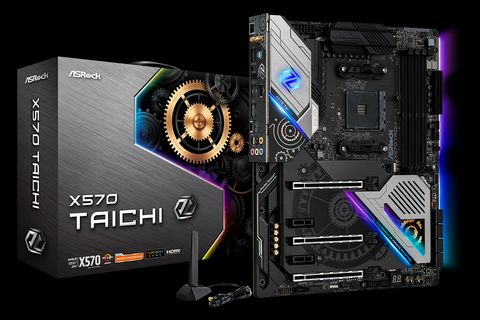Tom's Hardware Verdict
The X570 Taichi is a solid board, but we’d rather pay $20 less for it and have the convenience of easy M.2 slot access. We’d also like to see a firmware update that brings a default RPM slope to the 6000 RPM fan.
Pros
- +
Great performance
- +
Good overclocking
- +
802.11ax
Cons
- -
Priced-in top cover adds inconvenience
- -
Priced-in back cover offers little functionality
- -
Noisy fan must be manually turned down
Why you can trust Tom's Hardware
Features and Layout
ASRock dresses for success with a loaded and shrouded X570 Taichi motherboard, enabling most of AMD’s latest platform feature set when paired with a Ryzen 3000-series processor. Of course there are a few feature updates that weren’t addressed, such as that most of the board’s USB 3.x ports are of the Gen1 (5Gb/s) variety when the chipset supports Gen2 for all ports, but we expected a few small sacrifices from a sub-$300 X570 board. And sub-$300 it barely is, at $299.99.
ASRock X570 Taichi Specs
| Socket | AM4 |
| Chipset | AMD X570 |
| Form Factor | ATX |
| Voltage Regulator | 14 Phases |
| Video Ports | HDMI |
| USB Ports | 10Gbps: (1) Type-C, (1) Type A 5Gb/s: (6) Type A |
| Network Jacks | Gigabit Ethernet, (2) Wi-Fi Antenna |
| Audio Jacks | (5) Analog, (1) Digital Out |
| Legacy Ports/Jacks | (1) PS/2 |
| Other Ports/Jack | BIOS Flashback, CLR_CMOS Buttons |
| PCIe x16 | (3) v4.0 (x16/x0/x4*, x8/x8/x4*) (*Excluded by 3rd M.2) |
| PCIe x8 | ✗ |
| PCIe x4 | ✗ |
| PCIe x1 | (2) v4.0 |
| CrossFire/SLI | 3x / 2x |
| DIMM slots | (4) DDR4 |
| M.2 slots | (2) PCIe 4.0 x4 / SATA, (1) PCIe 4.0 x4 (3rd M.2 consumes four-lane x16 slot) |
| U.2 Ports | ✗ |
| SATA Ports | (8) 6Gb/s |
| USB Headers | (1) v3.x Gen2, (1) v3.x Gen1, (2) v2.0, (1) AMD fan LED |
| Fan Headers | (6) 4-Pin, (1) AMD LED fan |
| Legacy Interfaces | System (Beep-code) Speaker |
| Other Interfaces | FP-Audio, Thunderbolt AIC, ARGB LED, RGB LED |
| Diagnostics Panel | Numeric |
| Internal Button/Switch | Power, Reset / ✗ |
| SATA Controllers | Integrated (0/1/10) |
| Ethernet Controllers | WGI211AT PCIe |
| Wi-Fi / Bluetooth | Intel AX200 802.11ax (2.4 Gb/s) / BT 5.0 Combo |
| USB Controllers | ✗ |
| HD Audio Codec | ALC1220 |
| DDL/DTS Connect | DTS Connect |
| Warranty | 3 Years |

The X570 PCH’s expanded I/O means that slot layout is one of very few things that the new X570 Taichi has in common with its X470 predecessor’s design. Most of the previous board’s added features have been upgraded on the new model, such as Intel’s 2.4Gb/s AX200 module, bringing the new board up to 802.11ax / Wi-Fi 6 speed. The I/O panel adds firmware update and CLR_CMOS buttons, the third PCIe slot gets added metal reinforcement, and all slots support PCIe 4.0 mode.
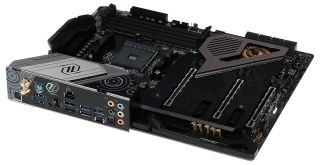
Total I/O panel USB count is eight, but only two of those (a Type A and a Type-C) support 10Gbps transfers while the remainder have only 5Gbps. This, it turns out, is a matter of cost rather than platform capability, as both the CPU and PCH support both standards. The single PS/2, HDMI, Gigabit Ethernet, and S/PDIF ports remain, and the Ethernet and Audio connections are still fed from the same i211AT controller and ALC1220 codec, so that the extra buttons and newer Wi-Fi appear to be the only I/O updates.

One of the newer features that isn’t completely obscured by sinks and shrouds are the fourteen chokes, for which circuitry leads to fourteen 50A MOSFETs which are paired up using phase doublers rather than the teamed design of its predecessor’s sixteen 30A phases. More power and smoother delivery are a given, and the firm also claims a reduction in overall temperature as well. All this despite the lower phase count, which means ASRock picked quality over quantity.

Surrounding a shroud that covers the X570 Taichi’s lower half are front-panel audio, Thunderbolt add-in card, TPM, addressable and classic RGB, one (of six) four-pin fan headers, PC speaker and legacy power LED, two dual-port USB 2.0, Intel-style front panel button/LED, eight SATA, USB 3 Gen2, AMD LED fan and fan LED, and a second (of the six) four pin fan headers. The Gen2 USB header supports 10Gb/s front panel port, and its complimentary two-port USB 3 Gen1 header is located further up the front edge. A two-digit diagnostics code display, power, reset, and CLR_CMOS buttons border the main front-panel header.
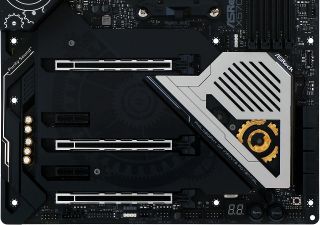
Peeling off the cover (after removing three socket-head screws), we find that the X570 Taichi supports three M.2 drives rather than its ancestor’s two. The third slot even has the space for those unusually-long 22110 drives, but alas its interface is shared with the third PCIe slot, so that they can’t be used simultaneously. Both PCIe x1 slots are open-ended to support longer cards (such as x4), but using the cover precludes that option as well. The PCH fan is factory configured to run at full speed, and even though it’s fairly quiet for its size, its nearly 6000 RPM makes the PC sound like it has a GeForce 2 constantly running Quake 3.
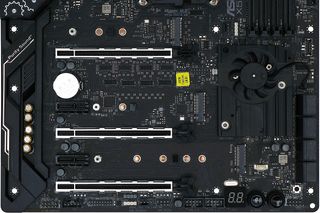
The back of the X570 Taichi is covered in black-anodized aluminum, which provides the builder the feel of increased quality even though we can’t think of any practical reason for that cover to be there once the PC has been assembled. It adds rigidity, but so does the case’s motherboard tray.
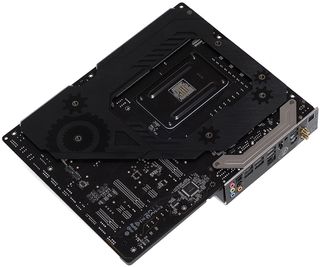
If similarities between the decorative gear on the top shroud to the techno-aesthetic reel-covers of late-80’s audio cassette decks didn’t catch the attention of older readers, perhaps the inclusion of a postcard will. Now where did I put those 35-cent stamps?

The rest of the support kit includes hardware and software manuals, a driver and application DVD, a classic high-bandwidth SLI bridge, a nicely-designed case-top Wi-Fi antenna with adhesive base, a 2mm hex socket screwdriver for the top shroud, four SATA cables, and a case badge.
MORE: Best Motherboards
MORE: How To Choose A Motherboard
MORE: All Motherboard Content
-
hannibal Yeah. 470 boards Are definitely better bang for the buck!Reply
Is there coming bigger 570 motherboard comparison? The sound of the motherboard cooler is a big thing. What board have the quitest options and settings? -
alextheblue Reply
For the most part I agree, we definitely need more X570 comparisons. I know the BIOS is still early but man, the chipset fan should have a proper ramp. That's a basic feature these days - for their sake I hope that was a bug in the shipping BIOS they didn't catch. However, to my surprise there are quite a few somewhat affordable X570 boards in the $150-160 range. Based on what we were hearing pre-launch I thought that the 400 series chipsets would be handling the sub-$200 range until B550 was ready. I'd like to see more overviews/comparisons done on the entry-level X570 boards.hannibal said:Yeah. 470 boards Are definitely better bang for the buck!
Is there coming bigger 570 motherboard comparison? The sound of the botherboard cooler is a big thing. What board have the quitest options and settings? -
splave "Finally, a test that really stands out! ASRock’s X570 Taichi consumed far more power at full load, and a quick search for the cause revealed that this board, and only this board, was running the 3700X at 1.31V and 4.1GHz under Prime95 small-FFTs. The other boards were running less than 1.2V, at 3.9 to 4.0 GHz in this test"Reply
So the asrock is running 200mhz more by default? Why do you consider this a bad thing. 😀😀 -
Crashman Reply
Because the peak power difference appears to have a negligible impact on real-world performance.splave said:"Finally, a test that really stands out! ASRock’s X570 Taichi consumed far more power at full load, and a quick search for the cause revealed that this board, and only this board, was running the 3700X at 1.31V and 4.1GHz under Prime95 small-FFTs. The other boards were running less than 1.2V, at 3.9 to 4.0 GHz in this test"
So the asrock is running 200mhz more by default? Why do you consider this a bad thing. 😀😀 -
ocer9999 I would say most users would be happier with higher clocks speeds than lower.Reply
You could always have spined like "The motherboard is the fastest of all the motherboards we have tested, but at energy efficency loss".
I'm pretty sure I want the fastest one :) -
tyr_antilles Reply
Because this causes the board to run hotter, consumes sensibly more power and at the end performance difference is not worth it. I always prefer a honest board that runs at default values and if I want more performance I will overclock it myself. I have 35 C temperature on my room and I do not want a hot board.splave said:So the asrock is running 200mhz more by default? Why do you consider this a bad thing. 😀😀
Other thing that concerns me is the small chipset fan on x570 boards. I remember older boards with these kind of high rotation fans and their longevity is very bad. After some time, dust get on the fan and it will stop functioning. Being custom made they are very hard to be replaced. I will buy a motherboard with passive cooling. -
Crashman Reply
Good luck: The old chipset heatpipe solution often didn't work right when the board was inverted, so none of the boards I've seen are using it.tyr_antilles said:Because this causes the board to run hotter, consumes sensibly more power and at the end performance difference is not worth it. I always prefer a honest board that runs at default values and if I want more performance I will overclock it myself. I have 35 C temperature on my room and I do not want a hot board.
Other thing that concerns me is the small chipset fan on x570 boards. I remember older boards with these kind of high rotation fans and their longevity is very bad. After some time, dust get on the fan and it will stop functioning. Being custom made they are very hard to be replaced. I will buy a motherboard with passive cooling. -
splave So I have spoken to an asrock contact. Companies are taking different positions. Some are undervolting vid at the risk of losing mhz with the benefit of lower power consumption and temps. In this case the gigabyte. Asrock and Asus both are pushing more voltage for more clocks at the cost of more power consumption and heat. With frequency being so low on these cpus I for one would take the extra 200mhz and the expense of 5 dollars more a week on my power bill. I wouldn't call it dishonesty just different thinking by each manufacturer. I wouldn't buy an expensive overclocking motherboard to undervolt it.Reply
